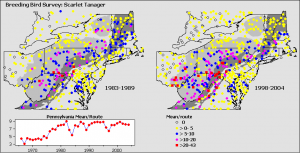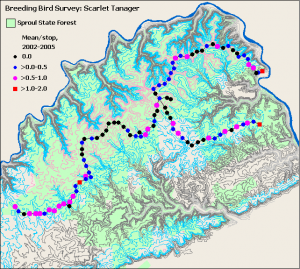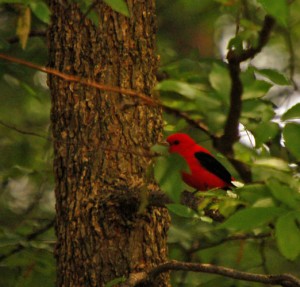By Bob Grump
The noted writer of books and articles, Marc Davis, was proud to put his name on our first guest essay, “Crows Await Second Coming.” But the following tirade, our second entry in the Guest Essay category, is written by a guy who gave us a fake name. His essay is pretty good though, so we don’t care if he wants an alias. Enjoy.
Actually, I wanted to entitle this “What the heck is a hectare.” Sounded better. (heck, hectare.) But it’s not two-fisted enough, the word heck. So I went with “What the hell is a hectare.” Which, while not making a word play with hectare, better expressed my feelings about the word “hectare.”
It all started a few years ago. I saw in a birding magazine that the Cornell Lab of Ornithology wanted volunteers to measure shrinking tanager populations. They said they’d specify an area near each volunteer’s home and supply a kit with maps, charts and questionnaires.

I don’t normally volunteer. But I was interested in tanagers and didn’t like the idea that they were declining. So I signed on. Soon I got my kit in the mail. It told me to claim a section of forest near my home and it described the area I should cover in terms of hectares.
I don’t remember how many. Just “hectares.” As in two hectares or five, like that. Not sure if they meant square hectares. All hectares are automatically square, right? What the hell is a hectare, anyway?
Okay, I don’t live on Mars. I know something about this word. It’s from the metric system that the rest of the world is trying to shove down the throats of Americans. And hectares are composed of something called “ares.” And an “are” (100 of them make a hectare) is a word useful only to crossword puzzle nuts.
Come on: Miles are now also expressed as kilometers. Feet as meters. Good old Fahrenheit temperatures have to appear with parenthetical Celsius numbers, just to confuse things.
Let’s use one system or another, okay? Keep using both and we’ll keep being confused. I ordered a load of logs for our fireplace and would have probably accepted a cord—also an unusual unit—but got a “stere.” What the hell is a stere?

Anyway, back to the tanagers and their territories. I set out to begin the study in good faith. But I just couldn’t get a handle on what a hectare was. So I quit. I dropped out.
All I had wanted was for the Cornell people to say: go to So-and-So Woods, bordered by this road and that road. Hike in, count the tanagers, mail us the information and have a nice day.
Instead I got vague directions about measuring hectares. I mailed the unused kit back to Cornell with my apologies. I assume the tanager study went on. I hope the tanagers are doing well. I still look for them every spring and I see a few.

They’re in the forest, which is measured in units I’ve heard of: miles, acres, paces. Things like that. But even those American measurements don’t matter. What matters are trees, streams, fields and the tanagers.
Science can take its hectares and put them wherever it wants. They lost a tanager counter because of the metric system. A system that someday I hope our scientists will get out of their system. But don’t count on it.





